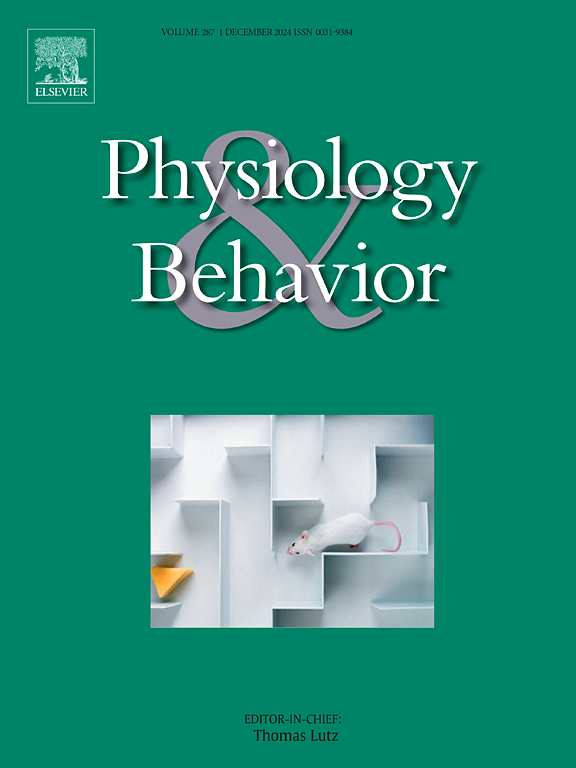A novel biting rod model for assessing aggressive behavior in restraint-stressed rats: Role of 5-HT3 receptor and NF-κB-kynurenine pathways
IF 2.5
3区 医学
Q2 BEHAVIORAL SCIENCES
引用次数: 0
Abstract
Preclinical models are essential for understanding the pathophysiology of intermittent explosive disorder (IED) in rodents. However, current models fail to fully uncover the molecular mechanisms behind restraint stress-induced aggression. We introduced a restrainer combined with a biting rod to measure IED-associated symptoms in stressed rats. Activation of 5-HT3 receptors promotes aggression by increasing pro-inflammatory cytokines and nuclear factor kappa B (NF-κB) activity in the brain. NF-κB, in turn, upregulates indoleamine 2,3-dioxygenase 1 (Ido1), which converts tryptophan (a serotonin precursor) into kynurenine, depleting serotonin levels in the amygdala. We examined the roles of 5-HT3 receptors and Ido1 in driving aggression in restrained-stressed rats. Aggressive behavior of rats was assessed in a restrainer with a biting assembly after ondansetron (5-HT3 antagonist) and minocycline (kynurenine pathway inhibitor) treatments. Pro-inflammatory cytokines and NF-κB levels in the amygdala were measured using ELISA and immunohistochemistry. HPLC quantified kynurenine and tryptophan, while Golgi-Cox staining analyzed dendritic spines. Restraint stress induced extensive biting (aggression), elevated pro-inflammatory cytokines (IL-1β, IL-6, TNF-α), and increased NF-κB expression in the amygdala. Elevated kynurenine and decreased tryptophan levels and dendritic spine density were also noticed. Blocking 5-HT3 receptors and inhibiting kynurenine pathway reduced cytokines, kynurenine, and restored tryptophan and spine density. Compared to existing methods, our model offers a more accurate assessment of restraint stress-induced aggression, incorporating molecular pathways and behavioral measures, enhancing understanding of IED. Moreover, stress-induced 5-HT3 signaling may activate NF-κB and kynurenine pathways in the amygdala, potentially contributing to the development of aggressive behavior in rodents.

一种评估约束应激大鼠攻击行为的咬棒新模型:5-HT3受体和NF-κ b -犬尿氨酸通路的作用。
临床前模型对于理解啮齿动物间歇性爆炸障碍(IED)的病理生理至关重要。然而,目前的模型未能完全揭示约束应激诱导攻击背后的分子机制。我们引入了一种结合咬杆的约束器来测量应激大鼠的ied相关症状。5-HT3受体的激活通过增加大脑中促炎细胞因子和NF-κB活性来促进攻击。反过来,NF-κB上调吲哚胺2,3-双加氧酶1 (Ido1),该酶将色氨酸(一种血清素前体)转化为犬尿氨酸,消耗杏仁核中的血清素。我们研究了5-HT3受体和Ido1在抑制应激大鼠攻击驱动中的作用。在昂丹西琼(5-HT3拮抗剂)和米诺环素(犬尿氨酸途径抑制剂)治疗后,大鼠的咬伤行为在一个带有咬伤组装的约束器中进行评估。采用ELISA和免疫组化方法检测大鼠杏仁核中促炎细胞因子和NF-κB水平。高效液相色谱法测定犬尿氨酸和色氨酸,高尔基-考克斯染色法测定树突棘。抑制应激诱导大鼠大范围咬伤,促炎细胞因子(IL-1β、IL-6、TNF-α)升高,杏仁核NF-κB表达升高。犬尿氨酸升高,色氨酸水平降低,树突棘密度升高。阻断5-HT3受体并抑制犬尿氨酸途径可降低细胞因子、犬尿氨酸,恢复色氨酸和脊柱密度。与现有方法相比,我们的模型提供了更准确的约束应激诱导攻击评估,结合分子途径和行为测量,增强了对IED的理解。此外,应激诱导的5-HT3信号可能激活杏仁核中的NF-κB和犬尿氨酸通路,可能有助于啮齿动物攻击行为的发展。
本文章由计算机程序翻译,如有差异,请以英文原文为准。
求助全文
约1分钟内获得全文
求助全文
来源期刊

Physiology & Behavior
医学-行为科学
CiteScore
5.70
自引率
3.40%
发文量
274
审稿时长
47 days
期刊介绍:
Physiology & Behavior is aimed at the causal physiological mechanisms of behavior and its modulation by environmental factors. The journal invites original reports in the broad area of behavioral and cognitive neuroscience, in which at least one variable is physiological and the primary emphasis and theoretical context are behavioral. The range of subjects includes behavioral neuroendocrinology, psychoneuroimmunology, learning and memory, ingestion, social behavior, and studies related to the mechanisms of psychopathology. Contemporary reviews and theoretical articles are welcomed and the Editors invite such proposals from interested authors.
 求助内容:
求助内容: 应助结果提醒方式:
应助结果提醒方式:


